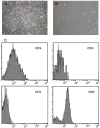Effect of neuroglobin genetically modified bone marrow mesenchymal stem cells transplantation on spinal cord injury in rabbits
- PMID: 23658829
- PMCID: PMC3642116
- DOI: 10.1371/journal.pone.0063444
Effect of neuroglobin genetically modified bone marrow mesenchymal stem cells transplantation on spinal cord injury in rabbits
Abstract
Objective: This study aims to investigate the potentially protective effect of neuroglobin (Ngb) gene-modified bone marrow mesenchymal stem cells (BMSCs) on traumatic spinal cord injury (SCI) in rabbits.
Methods: A lentiviral vector containing an Ngb gene was constructed and used to deliver Ngb to BMSCs. Ngb gene-modified BMSCs were then injected at the SCI sites 24 hours after SCI. The motor functions of the rabbits were evaluated by the Basso-Beattie-Bresnahan rating scale. Fluorescence microscopy, quantitative real-time PCRs, Western blots, malondialdehyde (MDA) tests, and terminal deoxynucleotidyltransferase-mediated UTP end labeling assays were also performed.
Results: Ngb expression in the Ngb-BMSC group increased significantly. A more significant functional improvement was observed in the Ngb-BMSC group compared with those in the other groups. Traumatic SCI seemingly led to an increase in MDA level and number of apoptotic cells, which can be prevented by Ngb-BMSC treatment.
Conclusion: This study demonstrates that Ngb gene-modified BMSCs can strengthen the therapeutic benefits of BMSCs in reducing secondary damage and improving the neurological outcome after traumatic SCI. Therefore, the combined strategy of BMSC transplantation and Ngb gene therapy can be used to treat traumatic SCI.
Conflict of interest statement
Figures









Similar articles
-
The protective effects of the lentivirus-mediated neuroglobin gene transfer on spinal cord injury in rabbits.Spinal Cord. 2012 Jun;50(6):467-71. doi: 10.1038/sc.2011.138. Epub 2011 Nov 22. Spinal Cord. 2012. PMID: 22105458
-
Overexpressing neuroglobin improves functional recovery by inhibiting neuronal apoptosis after spinal cord injury.Brain Res. 2014 May 8;1562:100-8. doi: 10.1016/j.brainres.2014.03.020. Epub 2014 Mar 24. Brain Res. 2014. PMID: 24675030
-
Effect of SDF-1/CXCR4 axis on the migration of transplanted bone mesenchymal stem cells mobilized by erythropoietin toward lesion sites following spinal cord injury.Int J Mol Med. 2015 Nov;36(5):1205-14. doi: 10.3892/ijmm.2015.2344. Epub 2015 Sep 14. Int J Mol Med. 2015. PMID: 26398409 Free PMC article.
-
[Progress on bone marrow mesenchymal stem cells transplantation for spinal cord injury].Zhongguo Gu Shang. 2014 May;27(5):437-40. Zhongguo Gu Shang. 2014. PMID: 25167680 Review. Chinese.
-
Bone marrow mesenchymal stem cells (BMSCs) improved functional recovery of spinal cord injury partly by promoting axonal regeneration.Neurochem Int. 2018 May;115:80-84. doi: 10.1016/j.neuint.2018.02.007. Epub 2018 Feb 16. Neurochem Int. 2018. PMID: 29458076 Review.
Cited by
-
Transplantation of neurotrophin-3-transfected bone marrow mesenchymal stem cells for the repair of spinal cord injury.Neural Regen Res. 2014 Aug 15;9(16):1520-4. doi: 10.4103/1673-5374.139478. Neural Regen Res. 2014. PMID: 25317169 Free PMC article.
-
Neural crest stem cells protect spinal cord neurons from excitotoxic damage and inhibit glial activation by secretion of brain-derived neurotrophic factor.Cell Tissue Res. 2018 Jun;372(3):493-505. doi: 10.1007/s00441-018-2808-z. Epub 2018 Mar 7. Cell Tissue Res. 2018. PMID: 29516218 Free PMC article.
-
Blockade of Neuroglobin Reduces Protection of Conditioned Medium from Human Mesenchymal Stem Cells in Human Astrocyte Model (T98G) Under a Scratch Assay.Mol Neurobiol. 2018 Mar;55(3):2285-2300. doi: 10.1007/s12035-017-0481-y. Epub 2017 Mar 22. Mol Neurobiol. 2018. PMID: 28332151
-
Gene-Modified Stem Cells for Spinal Cord Injury: a Promising Better Alternative Therapy.Stem Cell Rev Rep. 2022 Dec;18(8):2662-2682. doi: 10.1007/s12015-022-10387-z. Epub 2022 May 19. Stem Cell Rev Rep. 2022. PMID: 35587330 Review.
-
Characterization and differentiation potential of rabbit mesenchymal stem cells for translational regenerative medicine.In Vitro Cell Dev Biol Anim. 2014 Mar;50(3):251-60. doi: 10.1007/s11626-013-9702-5. Epub 2013 Oct 23. In Vitro Cell Dev Biol Anim. 2014. PMID: 24150687
References
-
- Young W (1993) Secondary injury mechanisms in acute spinal cord injury. J Emerg Med 11 Suppl 113–22. - PubMed
-
- Nakahara S, Yone K, Sakou T, Wada S, Nagamine T, et al. (1999) Induction of apoptosis signal regulating kinase 1 (ASK1) after spinal cord injury in rats: possible involvement of ASK1-JNK and -p38 pathways in neuronal apoptosis. J Neuropathol Exp Neurol 58: 442–450. - PubMed
-
- Beattie MS (2004) Inflammation and apoptosis: linked therapeutic targets in spinal cord injury. Trends Mol Med 10: 580–583. - PubMed
-
- Chen WH, Tzeng SF (2005) Pituitary adenylate cyclase-activating polypeptide prevents cell death in the spinal cord with traumatic injury. Neurosci Lett 384: 117–121. - PubMed
-
- Koda M, Murakami M, Ino H, Yoshinaga K, Ikeda O, et al. (2002) Brain-derived neurotrophic factor suppresses delayed apoptosis of oligodendrocytes after spinal cord injury in rats. J Neurotrauma 19: 777–785. - PubMed
Publication types
MeSH terms
Substances
LinkOut - more resources
Full Text Sources
Other Literature Sources
Medical
Molecular Biology Databases

